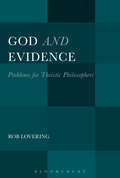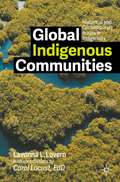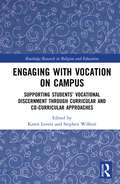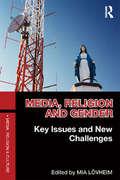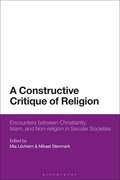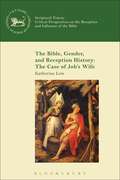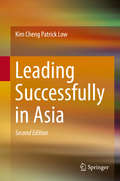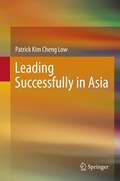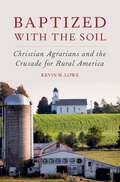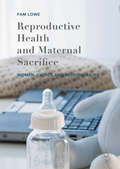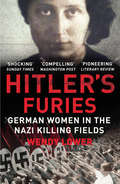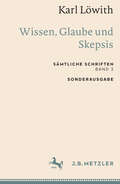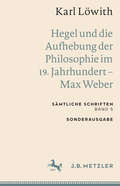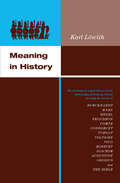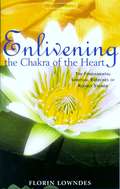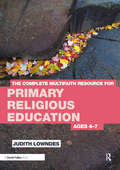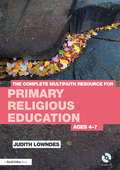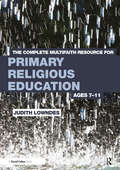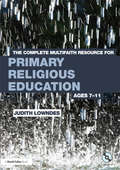- Table View
- List View
God and Evidence: Problems for Theistic Philosophers
by Rob LoveringGod and Evidence presents a new set of compelling problems for theistic philosophers. The problems pertain to three types of theistic philosopher, which Lovering defines here as 'theistic inferentialists,' 'theistic non-inferentialists,' and 'theistic fideists.' Theistic inferentialists believe that God exists, that there is inferential probabilifying evidence of God's existence, and that this evidence is discoverable not simply in principle but in practice. Theistic non-inferentialists believe that God exists, that there is non-inferential probabilifying evidence of God's existence, and that this evidence is discoverable not simply in principle but in practice. Theistic fideists believe that God exists, that there is no discoverable probabilifying evidence (inferential or non-inferential) of God's existence, and that it is nevertheless acceptable-morally if not otherwise-to have faith that God exists. Lovering argues that each type of theistic philosopher faces a problem unique to his type and that they all share two particular problems. Some of these problems take us down an entirely new discursive path; others down a new discursive path branching off from an old one.
God and Evidence: Problems for Theistic Philosophers
by Rob LoveringGod and Evidence presents a new set of compelling problems for theistic philosophers. The problems pertain to three types of theistic philosopher, which Lovering defines here as 'theistic inferentialists,' 'theistic non-inferentialists,' and 'theistic fideists.' Theistic inferentialists believe that God exists, that there is inferential probabilifying evidence of God's existence, and that this evidence is discoverable not simply in principle but in practice. Theistic non-inferentialists believe that God exists, that there is non-inferential probabilifying evidence of God's existence, and that this evidence is discoverable not simply in principle but in practice. Theistic fideists believe that God exists, that there is no discoverable probabilifying evidence (inferential or non-inferential) of God's existence, and that it is nevertheless acceptable-morally if not otherwise-to have faith that God exists. Lovering argues that each type of theistic philosopher faces a problem unique to his type and that they all share two particular problems. Some of these problems take us down an entirely new discursive path; others down a new discursive path branching off from an old one.
Global Indigenous Communities: Historical and Contemporary Issues in Indigeneity
by Lavonna L. LovernGlobal Indigenous Communities is a wide-ranging examination of global Indigenous communities that continue to suffer from colonization and assimilation issues, including intergenerational trauma. The scholarship is interdisciplinary; it is not easily categorized as sociology, anthropology, ethnography, or philosophy, but cuts across all of these disciplines, as well as Indigenous methodologies. The book not only presents an academic study of Indigenous issues, covering Indigenous community life, religion, the environment, economic matters, education, and healthcare, but also incorporates contributions from Carol Locust, EdD, that reflect on her lifetime of experience in Indigenous education and healthcare. Each studied prism of Indigenous life is revealed to be impacted by the experience of intergenerational trauma that results from continued colonization. Ultimately, this book aims to bridge the communication gap between Western and Indigenous scholarship and readership, artfully combining Indigenous approaches with a traditional academic style.
Engaging with Vocation on Campus: Supporting Students’ Vocational Discernment through Curricular and Co-Curricular Approaches (Routledge Research in Religion and Education)
by Karen Lovett Stephen WilhoitBringing together narratives and theory-based analyses of practice, this volume illustrates collaborative curricular and co-curricular approaches to promoting vocational discernment amongst students in a Catholic university setting. Drawing on cultural, religious, and secular understandings of vocation, Engaging with Vocation on Campus illustrates how contemporary issues around vocation, work, and careers can be addressed within the Catholic intellectual and spiritual tradition. Chapters presents a range of contributions from students, faculty, and staff from a single institution to highlight practical approaches to supporting students in this area, and acknowledge the complementary and intersecting roles played by student support services, academic staff, and on-campus ministry in helping students develop an individualised understanding of vocation. Considering the value of both curricular or non-curricular activities and processes, the volume highlights spiritual, personal, and community value in offering students explicit and tailored support. This text will benefit researchers, academics, and educators with an interest in higher education, religious education, and the Christian life and experience more broadly. Those specifically interested in career guidance, theological curriculum and pedagogy, and Roman Catholicism will also benefit from this book.
Media, Religion and Gender: Key Issues and New Challenges (Media, Religion and Culture)
by Mia LövheimMedia, Religion and Gender presents a selection of eminent current scholarship that explores the role gender plays when religion, media use and values in contemporary society interact. The book: surveys the development of research on media, religion and culture through the lens of key theoretical and methodological issues and debates within gender studies. includes case studies drawn from a variety of countries and contexts to illustrate the range of issues, theoretical perspectives and empirical material involved in current work outlines new areas and reflects on challenges for the future. Students of media, religion and gender at advanced level will find this a valuable resource, as will scholars and researchers working in this important and growing field.
Media, Religion and Gender: Key Issues and New Challenges (Media, Religion and Culture)
by Mia LövheimMedia, Religion and Gender presents a selection of eminent current scholarship that explores the role gender plays when religion, media use and values in contemporary society interact. The book: surveys the development of research on media, religion and culture through the lens of key theoretical and methodological issues and debates within gender studies. includes case studies drawn from a variety of countries and contexts to illustrate the range of issues, theoretical perspectives and empirical material involved in current work outlines new areas and reflects on challenges for the future. Students of media, religion and gender at advanced level will find this a valuable resource, as will scholars and researchers working in this important and growing field.
A Constructive Critique of Religion: Encounters between Christianity, Islam, and Non-religion in Secular Societies
by Mia Lövheim Mikael StenmarkWhy do some strategies for critique of religion seem to be more beneficial for constructive engagement, whereas others increase intolerance, polarization, and conflict?Through an analysis of the reasons underpinning a critique of religion in institutional contexts of secular democratic societies, A Constructive Critique of Religion explores how constructive interaction and critique can be developed across diverse interests. It shows how social and cultural conditions shaping these institutions enable and structure a critical and constructive engagement across diverging worldviews.A key argument running through the book is that to develop constructive forms of critique a more thorough and systematic investigation of resources for criticism located within religious worldviews themselves is needed. Chapters also address how critique of Islam and Christianity in particular is expressed in areas such as academia, the law, politics, media, education and parenting, with a focus on Northern Europe and North America. The interdisciplinary approach, which combines theoretical perspectives with empirical case studies, contributes to advancing studies of the complex and contentious character of religion in contemporary society.
The Bible, Gender, and Reception History: The Case of Job's Wife (Scriptural Traces #586)
by Katherine LowThe Bible, Gender, and Reception History: The Case of Job's Wife investigates the fleeting appearance in the Bible of Job's wife and its impact on the imaginations of readers throughout history. It begins by presenting key interpretive gaps in the biblical text concerning Job and his wife, explaining the way gender studies offers guiding principles with which the author engages a reception history of their marriage. After analyzing Job and his wife within medieval Christian theology of Eden, the author identifies ways in which Job's wife visually aligns with medieval images of Satan. The volume explores portrayals of Job and his wife in publications on marriage and gender roles in the sixteenth and seventeenth centuries, moving onto an investigation of William Blake's sharp artistic divergence from the common tradition in his representation of Job's wife as a shrew. In the exploration of societal portrayals of Job and his Wife throughout history, this book discovers how arguments about marriage intertwine with not only gender roles, but also, with political, social, and historical movements.
Leading Successfully in Asia
by Kim Cheng LowThis book examines the essence of leadership, its characteristics and its ways in Asia through a cultural and philosophical lens. Using Asian proverbs and other quotes, it discusses leadership issues and methods in key Asian countries including China, India, Japan, Kazakhstan, Malaysia and Singapore. It also explores the leadership styles of various great Asian political and corporate leaders. Further, it investigates several unique Asian philosophies, such as Buddhism, Guan Yin, Confucianism, Ta Mo, Chinese Animal zodiac signs, Hindu Gods, the Samurai, the Bushido Spirit and Zen in the context of leadership mastery and excellence. Offering numerous examples of a potpourri of the skills and insights needed to be a good, if not a great, leader, this practical, action-oriented book encourages readers to think, reflect and act.
Leading Successfully in Asia
by Patrick Kim LowThe book captures the essence of leadership, its characteristics and ways in Asia through the cultural and philosophical visor. With Asian sayings, proverbs and quotes, the book discusses leadership issues and ways in the major Asian countries including China, India, Indonesia, Japan, Malaysia and Singapore. The leadership styles and ways of various great Asian national leaders and corporate leaders in these Asian countries are also examined. Perhaps of much interest to scholars and students of leadership, certain unique Asian features such as Buddhism, Confucianism, Ta Mo, Chinese Animal zodiac signs, Hindu Gods, the Samurai, the Spirit of Bushido and Zen are examined in the light of leadership mastery and excellence. The book is also intended to be a practical book that gives numerous examples of a potpourri of leadership skills and ways a person needs to be a leader. It is very action-orientated, the reader is urged to think about it, reflect and act.
Baptized with the Soil: Christian Agrarians and the Crusade for Rural America
by Kevin M. LoweIn the early twentieth century, many Americans were troubled by the way agriculture was becoming increasingly industrial and corporate. Mainline Protestant churches and cooperative organizations began to come together to promote agrarianism: the belief that the health of the nation depended on small rural communities and family farms. In Baptized with the Soil, Kevin M. Lowe offers for the first time a comprehensive history of the Protestant commitment to rural America. Christian agrarians believed that farming was the most moral way of life and a means for people to serve God by taking care of the earth that God created. When the Great Depression hit, Christian agrarians worked harder to keep small farmers on the land. They formed alliances with state universities, cooperative extension services, and each other's denominations. They experimented with ways of revitalizing rural church life--including new worship services like Rural Life Sunday, and new strategies for raising financial support like the Lord's Acre. Because they believed that the earth was holy, Christian agrarians also became leaders in promoting soil conservation. Decades before the environmental movement, they inspired an ethic of environmental stewardship in their congregations. They may not have been able to prevent the spread of industrial agribusiness, but their ideas have helped define significant and long-lasting currents in American culture.
Baptized with the Soil: Christian Agrarians and the Crusade for Rural America
by Kevin M. LoweIn the early twentieth century, many Americans were troubled by the way agriculture was becoming increasingly industrial and corporate. Mainline Protestant churches and cooperative organizations began to come together to promote agrarianism: the belief that the health of the nation depended on small rural communities and family farms. In Baptized with the Soil, Kevin M. Lowe offers for the first time a comprehensive history of the Protestant commitment to rural America. Christian agrarians believed that farming was the most moral way of life and a means for people to serve God by taking care of the earth that God created. When the Great Depression hit, Christian agrarians worked harder to keep small farmers on the land. They formed alliances with state universities, cooperative extension services, and each other's denominations. They experimented with ways of revitalizing rural church life--including new worship services like Rural Life Sunday, and new strategies for raising financial support like the Lord's Acre. Because they believed that the earth was holy, Christian agrarians also became leaders in promoting soil conservation. Decades before the environmental movement, they inspired an ethic of environmental stewardship in their congregations. They may not have been able to prevent the spread of industrial agribusiness, but their ideas have helped define significant and long-lasting currents in American culture.
Reproductive Health and Maternal Sacrifice: Women, Choice and Responsibility
by Pam LoweThis book demonstrates that the symbol of maternal sacrifice is the notion that 'proper' women put the welfare of children, whether born, in utero or not conceived, over and above any choices and desires of their own. The idea of maternal sacrifice acts as powerful signifier in judging women's behaviour that goes beyond necessary care for any children. The book traces its presence in various aspects of reproductive health, from contraception to breastfeeding. Pam Lowe shows how although nominally choices are presented to women around reproductive health, maternal sacrifice is used to discipline women into conforming to specific norms, reasserting traditional forms of womanhood. This has significant implications for women's autonomy. Women can resist or reject this disciplinary position when making reproductive decisions, but in doing so, they may be positioned as transgressing and/or need to justify their decisions. The book will be of great interest to scholars of sociology, gender studies and health studies.
Hitler's Furies: German Women in the Nazi Killing Fields
by Wendy LowerHitler’s Furies is the untold story of the Holocaust. History has it that the role of women in Nazi Germany was to be the perfect Hausfrau and a loyal cheerleader for the Führer. However, Lower’s research reveals an altogether more sinister truth. Lower shows us the ordinary women who became perpetrators of genocide. Drawing on decades of research, she uncovers a truth that has been in the shadows – that women too were brutal killers and that, in ignoring women’s culpability, we have ignored the reality of the Holocaust.‘Shocking’ Sunday Times‘ Compelling’ Washington Post ‘Pioneering’ Literary ReviewA National Book Award Finalist
Karl Löwith: Sämtliche Schriften, Band 3
by Karl LöwithDer dritte Band der Sämtlichen Schriften des Philosophen Karl Löwith faßt die Arbeiten aus vier Jahrzehnten zusammen, in denen er sich mit dem christlichen Offenbarungsdenken und der protestantischen Theologie auseinandergesetzt hat. Löwith macht den Versuch, das Verhältnis von christlicher Theologie und Philosophie in seinem geschichtlichen Verlauf zu erörtern und sachlich zu klären. Seine Skepsis bekundet sich in der Behauptung, daß das philosophische Fragen von sich aus kein Verhältnis zur Antwort des christlichen Glaubens hat. Vielmehr hat sich der christliche Glaube an Gottes Offenbarung als ein diesseitiges, geschichtliches Faktum gegenüber der philosophischen Skepsis zu rechtfertigen, die zwangsläufig wach werden muß, wenn so gegensätzliche Begriffe wie Glauben und Wissen ineins gesetzt werden. Auch in den Abhandlungen dieses Bandes ist die andernorts geleistete Kritik an christlich inspirierter Geschichtsphilosophie und -anthropologie (»Weltgeschichte und Heilsgeschehen«, »Mensch und Menschenwelt«) ständig gegenwärtig: »Kein Mensch ist von Natur aus ein gläubiger Christ, wohl aber alles, was ist, bedenkend«.
Karl Löwith: Sämtliche Schriften, Band 5
by Karl LöwithLöwiths Beschäftigung mit der deutschen Philosophie des 19. Jahrhunderts reicht zurück bis in die zwanziger Jahre und hat die kritische Revision der zeitgenössischen Auseinandersetzung mit dem Werk Nietzsches als Ausgangspunkt. Löwith richtet sein Augenmerk verstärkt auf die Verwissenschaftlichung des philosophischen Denkens und die neuartige deutsche Form der Religionskritik, auf die Entstehung des wissenschaftlichen Sozialismus und der bürgerlichen Soziologie. Mit diesen Ausarbeitungen befindet sich Löwith bereits im Vorfeld seines erstmals 1941 erschienenen Buchs Von Hegel zu Nietzsche (Bd. 4), in dem er den revolutionären, die Philosophiegeschichte des 19. Jahrhunderts bestimmenden Bruch mit dem Systemdenken Hegels beschrieben hat. Seine kritische Aufmerksamkeit gilt aber auch der von Nietzsche beschworenen Heraufkunft des europäischen Nihilismus, dem der träumende Freigeist sein der griechischen Antike entlehntes Ideal einer ewigen Wiederkunft des Gleichen entgegengesetzt hat. Löwiths Beschäftigung mit Hegel und seinen Kritikern endet schließlich 1971 in einem Vortrag, kurz vor seinem Tod, mit der Frage: »Wenn Hegel noch immer aktuell ist, dann ist er es gerade deshalb, weil er die gesamte Tradition der nachchristlichen Metaphysik beendet hat, so daß die Frage entstehen konnte und mußte: Wie soll es nach Hegel überhaupt noch Metaphysik geben können?« Eine Frage, die hinter Löwiths gesamter skeptischer Beschäftigung mit Martin Heideggers Seinsphilosophie steht. Einen Gegenpol bildet der Eindruck, den Max Weber mit seiner Auffassung von wissenschaftlicher Würde und Verantwortung auf den jungen Studenten Karl Löwith gemacht hat. Die drei Studien, die Löwith ihm im Laufe der Jahrzehnte gewidmet hat, werden daher in diesem Band erneut abgedruckt.
Meaning in History: The Theological Implications of the Philosophy of History
by Karl LöwithModern man sees with one eye of faith and one eye of reason. Consequently, his view of history is confused. For centuries, the history of the Western world has been viewed from the Christian or classical standpoint—from a deep faith in the Kingdom of God or a belief in recurrent and eternal life-cycles. The modern mind, however, is neither Christian nor pagan—and its interpretations of history are Christian in derivation and anti-Christian in result. To develop this theory, Karl Löwith—beginning with the more accessible philosophies of history in the nineteenth and eighteenth centuries and working back to the Bible—analyzes the writings of outstanding historians both in antiquity and in Christian times. "A book of distinction and great importance. . . . The author is a master of philosophical interpretation, and each of his terse and substantial chapters has the balance of a work of art."—Helmut Kuhn, Journal of Philosophy
Meaning in History: The Theological Implications of the Philosophy of History
by Karl LöwithModern man sees with one eye of faith and one eye of reason. Consequently, his view of history is confused. For centuries, the history of the Western world has been viewed from the Christian or classical standpoint—from a deep faith in the Kingdom of God or a belief in recurrent and eternal life-cycles. The modern mind, however, is neither Christian nor pagan—and its interpretations of history are Christian in derivation and anti-Christian in result. To develop this theory, Karl Löwith—beginning with the more accessible philosophies of history in the nineteenth and eighteenth centuries and working back to the Bible—analyzes the writings of outstanding historians both in antiquity and in Christian times. "A book of distinction and great importance. . . . The author is a master of philosophical interpretation, and each of his terse and substantial chapters has the balance of a work of art."—Helmut Kuhn, Journal of Philosophy
Meaning in History: The Theological Implications of the Philosophy of History
by Karl LöwithModern man sees with one eye of faith and one eye of reason. Consequently, his view of history is confused. For centuries, the history of the Western world has been viewed from the Christian or classical standpoint—from a deep faith in the Kingdom of God or a belief in recurrent and eternal life-cycles. The modern mind, however, is neither Christian nor pagan—and its interpretations of history are Christian in derivation and anti-Christian in result. To develop this theory, Karl Löwith—beginning with the more accessible philosophies of history in the nineteenth and eighteenth centuries and working back to the Bible—analyzes the writings of outstanding historians both in antiquity and in Christian times. "A book of distinction and great importance. . . . The author is a master of philosophical interpretation, and each of his terse and substantial chapters has the balance of a work of art."—Helmut Kuhn, Journal of Philosophy
Meaning in History: The Theological Implications of the Philosophy of History
by Karl LöwithModern man sees with one eye of faith and one eye of reason. Consequently, his view of history is confused. For centuries, the history of the Western world has been viewed from the Christian or classical standpoint—from a deep faith in the Kingdom of God or a belief in recurrent and eternal life-cycles. The modern mind, however, is neither Christian nor pagan—and its interpretations of history are Christian in derivation and anti-Christian in result. To develop this theory, Karl Löwith—beginning with the more accessible philosophies of history in the nineteenth and eighteenth centuries and working back to the Bible—analyzes the writings of outstanding historians both in antiquity and in Christian times. "A book of distinction and great importance. . . . The author is a master of philosophical interpretation, and each of his terse and substantial chapters has the balance of a work of art."—Helmut Kuhn, Journal of Philosophy
Enlivening the Chakra of the Heart: The Fundamental Spiritual Exercises of Rudolf Steiner
by Florin LowndesThe seer and teacher Rudolf Steiner advised that specific 'accompanying' or 'fundamental' spiritual exercises should always be carried out in conjunction with meditation. While meditation is the foundation of any spiritual path of development, it can pose dangers to normal consciousness. These exercises offer a protection, by helping to develop inner certainty and strength. This is achieved, for example, through the first exercise by concentrating and intensifying the powers of thinking, through the second by developing the control of the will, through the third by mastering the outer expressions of the life of feeling, and so on. Florin Lowndes describes the fundamental exercises in thorough detail, giving suggestions as to how they may be carried out. He also relates an important and hidden aspect - that the exercises embody the means for developing and strengthening organic and 'living' thinking, which is intimately related to the enlivening of a new organ of perception: the heart chakra or lotus. Lowndes casts new light on many aspects of this question, and offers encouragement and stimulus to those seeking a modern path of spiritual development. FLORIN LOWNDES was born in Romania in 1938 and had an international career in architectural art and design. In 1970 he emigrated to the United States, where he taught at college level and in Steiner Waldorf schools. Since 1971 he has been engaged in the study of anthroposophy, and has written many articles for journals on related questions. He co-authored The Human Life, and founded the Center of Heart-Thinking in Boston. At present he leads training seminars in the United States and throughout Europe.
The Complete Multifaith Resource for Primary Religious Education: Ages 4-7
by Judith LowndesThe Complete Multifaith Resource for Primary Religious Education Ages 4-7 is a definitive teaching and learning aid for cross-religious exploration in the classroom, offering stimulating and detailed ways in which to apply a concepts-based approach to the teaching of RE. It provides a model for learning which engages children and encourages the development of higher order thinking skills and which can be applied to other subject areas in a cross- curricular setting. Comprising of a book and CD-ROM, The Complete Multifaith Resource features key concepts that underpin religious beliefs and practices and that are key to effective learning in RE for the target age level. Each concept chapter provides a wealth of material which will enable teachers to lead their pupils through the learning experience. Resources can be displayed on an interactive whiteboard for classroom viewing, or alternatively printed out for pupils to use during individual and group activities, requiring no further search for resources. This includes: stories, pictures and questions to prompt discussion writing frames, sort cards, matching pairs and other engaging activities This indispensable tool provides a modern, innovative and refreshing approach to teaching RE that has already proved to be effective in a large number of schools and can be applied to the effective delivery of an agreed syllabus for RE. Each chapter is introduced by looking at the key concept from a Christian point of view, and is then examined from the perspectives of the other major world faiths, including Buddhism, Judaism, Islam, Hinduism and Sikhism. The Complete Multifaith Resource for Primary Religious Education Ages 4-7 will be of value not only to RE managers and leaders, but also to primary phase teachers who may have little confidence or expertise in teaching RE. Trainee teachers and those studying on education courses will also benefit from gaining a better understanding of the concepts-based approach to the teaching of RE as expounded by the Hampshire, Portsmouth and Southampton Agreed Syllabus.
The Complete Multifaith Resource for Primary Religious Education: Ages 4-7
by Judith LowndesThe Complete Multifaith Resource for Primary Religious Education Ages 4-7 is a definitive teaching and learning aid for cross-religious exploration in the classroom, offering stimulating and detailed ways in which to apply a concepts-based approach to the teaching of RE. It provides a model for learning which engages children and encourages the development of higher order thinking skills and which can be applied to other subject areas in a cross- curricular setting. Comprising of a book and CD-ROM, The Complete Multifaith Resource features key concepts that underpin religious beliefs and practices and that are key to effective learning in RE for the target age level. Each concept chapter provides a wealth of material which will enable teachers to lead their pupils through the learning experience. Resources can be displayed on an interactive whiteboard for classroom viewing, or alternatively printed out for pupils to use during individual and group activities, requiring no further search for resources. This includes: stories, pictures and questions to prompt discussion writing frames, sort cards, matching pairs and other engaging activities This indispensable tool provides a modern, innovative and refreshing approach to teaching RE that has already proved to be effective in a large number of schools and can be applied to the effective delivery of an agreed syllabus for RE. Each chapter is introduced by looking at the key concept from a Christian point of view, and is then examined from the perspectives of the other major world faiths, including Buddhism, Judaism, Islam, Hinduism and Sikhism. The Complete Multifaith Resource for Primary Religious Education Ages 4-7 will be of value not only to RE managers and leaders, but also to primary phase teachers who may have little confidence or expertise in teaching RE. Trainee teachers and those studying on education courses will also benefit from gaining a better understanding of the concepts-based approach to the teaching of RE as expounded by the Hampshire, Portsmouth and Southampton Agreed Syllabus.
The Complete Multifaith Resource for Primary Religious Education: Ages 7-11
by Judith LowndesThe Complete Multifaith Resource for Primary Religious Education Ages 7-11 is a definitive teaching and learning aid for cross-religious exploration in the classroom, offering stimulating and detailed ways in which to apply a concepts-based approach to the teaching of RE. It provides a model for learning which engages children and encourages the development of higher order thinking skills and which can be applied to other subject areas in cross-curricular settings. Comprising of a book and CD-ROM, The Complete Multifaith Resource features key concepts that underpin religious beliefs and practices and that are key to effective learning in RE for the target age level. Each concept chapter provides a wealth of material which will enable teachers to lead their pupils through the learning experience. Resources can be displayed on an interactive whiteboard for classroom viewing, or alternatively printed out for pupils to use during individual and group activities, requiring no further search for resources. This includes: stories, pictures and questions to prompt discussion writing frames, sort cards, matching pairs and other engaging activities This indispensable tool provides a modern, innovative and refreshing approach to teaching RE that has already proved to be effective in a large number of schools and can be applied to the effective delivery of an agreed syllabus for RE. Each chapter is introduced by looking at the key concept from a Christian point of view, and is then examined from the perspectives of the other major world faiths, including Buddhism, Judaism, Islam, Hinduism and Sikhism. The Complete Multifaith Resource for Primary Religious Education Ages 7-11 will be of value not only to RE managers and leaders, but also to primary phase teachers who may have little confidence or expertise in teaching RE. Trainee teachers and those studying on education courses will also benefit from gaining a better understanding of the concepts-based approach to the teaching of RE as expounded by the Hampshire, Portsmouth and Southampton Agreed Syllabus.
The Complete Multifaith Resource for Primary Religious Education: Ages 7-11
by Judith LowndesThe Complete Multifaith Resource for Primary Religious Education Ages 7-11 is a definitive teaching and learning aid for cross-religious exploration in the classroom, offering stimulating and detailed ways in which to apply a concepts-based approach to the teaching of RE. It provides a model for learning which engages children and encourages the development of higher order thinking skills and which can be applied to other subject areas in cross-curricular settings. Comprising of a book and CD-ROM, The Complete Multifaith Resource features key concepts that underpin religious beliefs and practices and that are key to effective learning in RE for the target age level. Each concept chapter provides a wealth of material which will enable teachers to lead their pupils through the learning experience. Resources can be displayed on an interactive whiteboard for classroom viewing, or alternatively printed out for pupils to use during individual and group activities, requiring no further search for resources. This includes: stories, pictures and questions to prompt discussion writing frames, sort cards, matching pairs and other engaging activities This indispensable tool provides a modern, innovative and refreshing approach to teaching RE that has already proved to be effective in a large number of schools and can be applied to the effective delivery of an agreed syllabus for RE. Each chapter is introduced by looking at the key concept from a Christian point of view, and is then examined from the perspectives of the other major world faiths, including Buddhism, Judaism, Islam, Hinduism and Sikhism. The Complete Multifaith Resource for Primary Religious Education Ages 7-11 will be of value not only to RE managers and leaders, but also to primary phase teachers who may have little confidence or expertise in teaching RE. Trainee teachers and those studying on education courses will also benefit from gaining a better understanding of the concepts-based approach to the teaching of RE as expounded by the Hampshire, Portsmouth and Southampton Agreed Syllabus.
